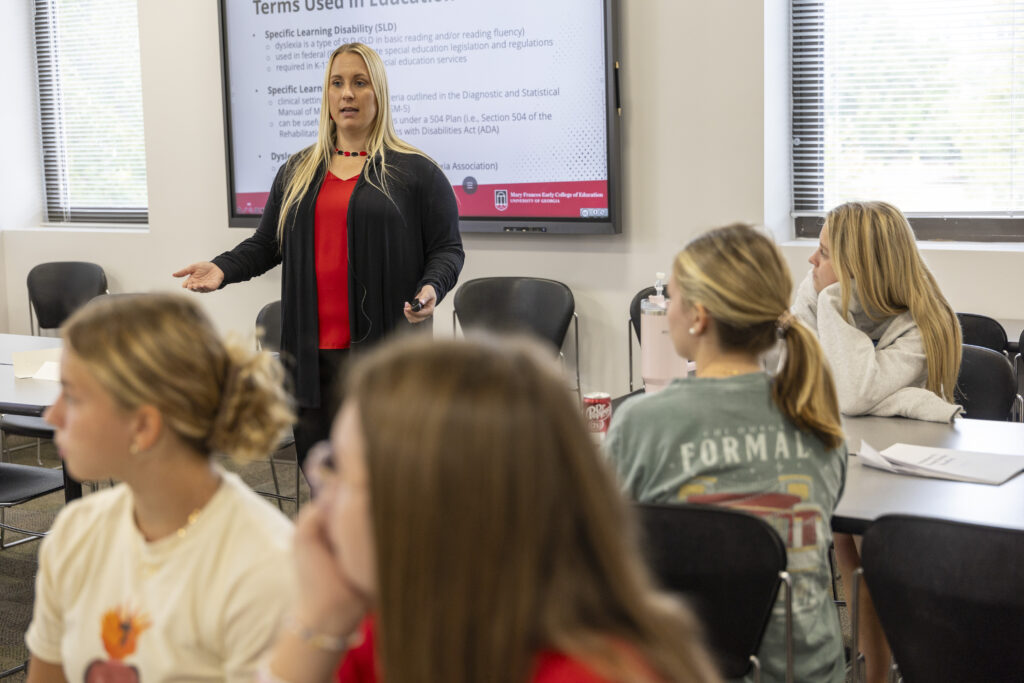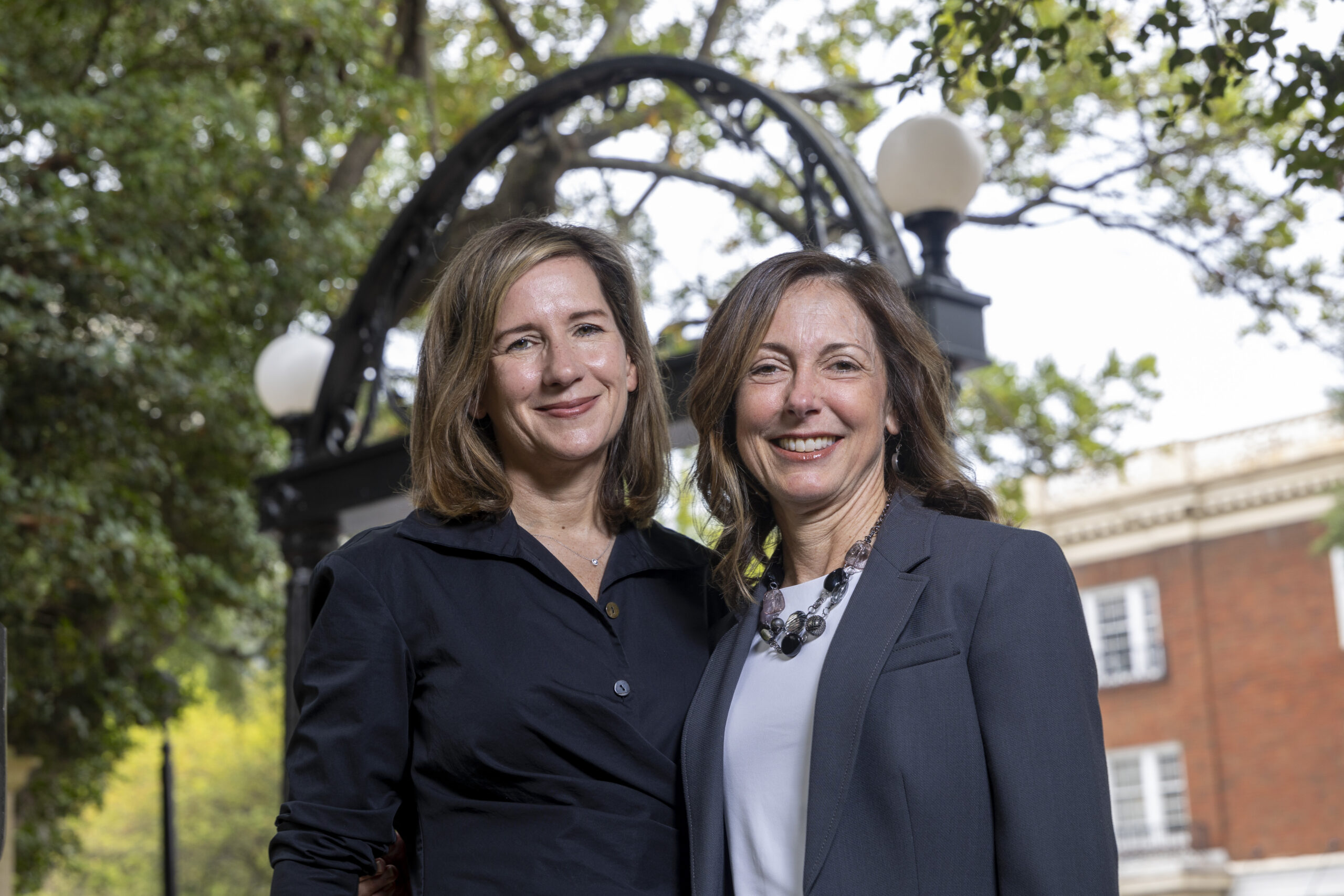From the time he started elementary school, Richard W. Courts IV struggled with conventional learning. He was smart, no doubt, but reading, spelling, and math were a challenge.
In sixth grade, he found out why.
Courts was diagnosed with dyslexia, the most common learning difference among school-aged children.
“It’s just a different way of thinking,” Courts says. “Having dyslexia taught me from an early age how to struggle and be comfortable struggling. And that’s a great life skill.”
Working through those struggles gave him the tools he needed to thrive. Courts BBA ’95 earned a finance degree from the Terry College of Business. Since graduating, Courts has been a leader in the commercial real estate business in Atlanta and is president of the Atlantic Realty Company. He’s held the role since 2012.

Throughout his career, Courts has also worked hard to give back to his community. In 2014, he served on the board of Atlanta’s Schenck School, which specializes in teaching children with dyslexia and other language-based learning differences in grades K-6. He’d also recently joined the UGA Foundation Board of Trustees.
Through that role, Courts learned about some intriguing work coming out of the Mary Frances Early College of Education. Associate professors Kristin Sayeski and Jennifer Lindstrom PhD ’06 were putting together a 15-hour graduate certificate program designed to provide educational professionals with specific knowledge and skills related to language development and reading disabilities.
They wanted to help teach teachers how to work with children diagnosed with dyslexia and specific learning disabilities.
Now an emeritus trustee, Courts would be the first person to say his involvement was minimal. He’d also be the only person to say that. He helped bring these varied groups together, including UGA faculty and administrators, and Schenck leaders, who provided subject matter expertise. Their ideas became a proposal, and in 2016, that proposal became UGA’s Dyslexia Endorsement and Certificate Program, the first of its kind in the state.
Since the launch of the certificate program, UGA has grown into a national leader in the training of teachers who work in the field of dyslexia. The university’s efforts and influence reach beyond the campus and into schools, classrooms, teacher workspaces, and even the halls of Georgia’s legislature.
“All the data and research show that the sooner you get help, the greater the impact it’s going to have,” says Courts, who has since stepped back from his board and foundation positions but remains supportive of the work. “It just excites me to know that there are folks out there who are pushing the boundaries and using the science and the skills we have to teach our future educators for years.”
Building a Program
Kristin Sayeski wrote the book on dyslexia education.
Unraveling Dyslexia: A Guide for Teachers and Families was released in 2023 by the academic publisher Rowman & Littlefield.
It’s a guidebook for educators and parents seeking to improve learning outcomes for students with dyslexia. Unraveling Dyslexia is also a required textbook in more than one class in the College of Education.

“Conducting the research was fascinating, and it has informed my teaching,” Sayeski says about the process, which took 18 months. “I thought about what my UGA students want to know, and I could have sent them to four different articles and six different podcasts, but now I just ask them to read a chapter.”
When Sayeski came to the University of Georgia in 2011, she met Jennifer Lindstrom, who joined the College of Education faculty two years earlier to teach special education courses.
Lindstrom had ambitious ideas.
She wanted the college’s curriculum to focus more on literacy, reading, reading instruction, and teacher preparation. Sayeski shared those ambitions, and it took her arrival, and her partnership, to make that shift possible.
“I felt like I wasn’t doing this alone,” Lindstrom says.
The Dyslexia Endorsement and Certificate Program, which they continue to co-direct, was one of their first achievements and by no means their last.
In 2018, Lindstrom testified in front of a state senate committee on special education. Her subject matter expertise was influential in the passage of the Dyslexia Law in 2019 and the Georgia Early Literacy Act in 2023, which emphasize literacy and dyslexia screening as well as teacher training for students and teachers in elementary school.
In 2021, the Georgia Department of Education named Lindstrom its first statewide dyslexia coordinator. As part of that role, she travels to school districts throughout the state to meet with teachers and school administrators. It’s also common for teachers to ask Lindstrom for advice about how to incorporate interventions and supports into their curricula to meet the needs of students with and at risk for dyslexia.
And sometimes those teachers just need a pep talk.
“Jennifer is so good about responding to every email,” Sayeski says about her colleague. “She schedules private Zoom meetings with people. She just goes above and beyond.”
An Innovative Classroom
Experts estimate that between 5% and 12% of the population has dyslexia, although the real number could be higher. Because learning falls on a continuum, some children (and, of course, adults) may exhibit signs that are related to a dyslexia diagnosis without necessarily having dyslexia.
The college continues to approach dyslexia-related teaching and research from a variety of angles.
For instance, the Mary Frances Early College of Education and the Georgia Department of Education partnered to launch a series of animated YouTube videos, created by Sayeski, that explores the relationship between dyslexia and reading instruction and give teachers helpful hints on working with students with dyslexia.
Elsewhere in the department, assistant professor Kelly Williams received a grant from the U.S. Department of Education’s Institute of Education Sciences for a four-year project to develop a reading intervention program for middle school students with dyslexia. She is partnering with teachers and schools in Jackson County, just north of Athens. If the project is successful, Williams hopes to expand it across the state.
“I worked with students with learning disabilities, which includes dyslexia, and many of them were not graduating,” says Williams, who—like Sayeski and Lindstrom—was a special education teacher before entering academia. She came to UGA in 2023, and her teaching load includes a First-Year Odyssey seminar, Dyslexia and Reading Disabilities.

“I wanted to know how we could better help those kids,” she continues, “and how we could use evidence-based practices to improve their reading outcomes.”
The work in Jackson County is not UGA’s only current dyslexia outreach effort. In June, 10 education students spent four weeks at the Schenck School providing reading interventions for 30 students from the Metro area.
Many of the young students, who were first, second, and third graders, had been diagnosed with dyslexia. The UGA students helped the pupils develop both their word reading and language comprehension, spending two hours each day on phonics, spelling, word recognition, reading comprehension, and writing. The UGA students used the skills acquired in their coursework and were mentored and coached by supervisors who specialize in supporting students with dyslexia.
There are a variety of innovative teaching processes that address dyslexia. Students with dyslexia often benefit when teachers break down skills into smaller, more manageable steps. They also need more repetitions of practice to gain proficiency. This means spending more time on a topic or skill and distributing learning across time—sometimes days or weeks. Finally, providing a mnemonic or physical prompt, such as biting an apple to remember the short /ă/ sound, also supports learning.
“In just a few weeks, I saw students make great progress,” says Anna Boswell, a fourth-year elementary education major. “Learning how to teach students and receiving feedback and professional development from trained specialists added so much to my ability to teach structured literacy lessons.”
Sayeski and Williams spearheaded the effort, which also includes a research aspect related to the literacy and language outcomes of the young students.
“The most exciting part of this project is to see the translation of what our dyslexia endorsement students have been learning in our program and then getting to see them implement and practice with young students in real time,” Sayeski says.
What is Dyslexia?
Adopted by the International Dyslexia Association (IDA) in 2002, dyslexia is defined, in part, as “a specific learning disability that is neurobiological in origin. It is characterized by difficulties with accurate and/or fluent word recognition and by poor spelling and decoding abilities. Secondary consequences may include problems in reading comprehension and reduced reading experience that can impede growth of vocabulary and background knowledge.”
It’s an overly formal, not-easily-penetrable statement that after 22 years may be changing. The IDA formed a steering committee to review this definition, and it could be updated as soon as next year.
“Not unlike autism or other areas of disability, we are learning more through increased research,” says Lindstrom. “Dyslexia is not always what we thought it was.”
Sayeski’s description is much more straight-forward than that of the IDA.
“The key question for parents is, ‘What does my child need that is different because they have dyslexia? What are the skills my child struggles with?’” asks Sayeski. She follows with a detailed answer.
“They are having difficulty understanding how alphabetic languages work and how to map speech sounds to letters and letter patterns.
“We weren’t having kids pay attention to individual parts of words. Now there is systematic instruction. Let’s talk about what this speech sound is and how do we spell this sound. There is an alphabetic code here, and this is how we unlock it.”


